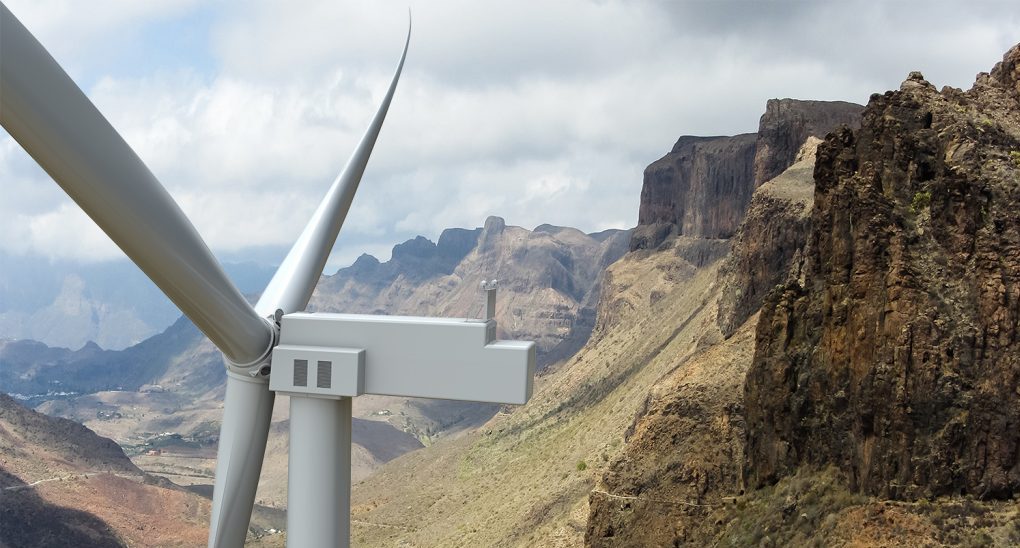

WIND TURBINES OF CHANGE
Engineers may not be able to command the weather, but they’re getting better at harnessing as much wind as possible by bringing wind turbines to blustery places where logistically it could not have been done before.
Bespoke turbines: A powerful wind turbine can be a bit like an off-the-rack designer suit. When you put it on, it bulges over the shoulder and the sleeves are too long. But if a skilled in-house tailor works their magic, you can walk around looking like a million bucks. That’s also the plan for GE Renewable Energy’s new Cypress platform of powerful onshore wind turbines. Building off the core technology, engineers can tailor the wind turbines to optimize their annual output by varying component specifications like generator rating, tower height and noise rating in order to match local grid connection requirements or prevailing wind patterns. The platform also includes a 77-meter jointed blade with varying options for tip length, making it possible to transport these massive blades in two pieces through twisting roads in a hilly terrain and assemble them at the site.
Read more about the turbines here.
JET TECH SCAVENGER HUNT
It’s been a grueling but immensely enjoyable summer for aviation fans, starting in July with England’s high-profile Farnborough Airshow followed by the world’s greatest flying festival: the EAA AirVenture Oshkosh fly-in at Wittman Regional Airport in Wisconsin.
Seeing it all: While Farnborough is primarily about big business, Oshkosh is about passion. Large companies like GE Aviation, Boeing, Airbus and others all have booths at Oshkosh, but more than 10,000 pilots, their families and friends arrive in their own planes to the event. Guests enjoy the afternoon and nighttime airshows, attend plane-building workshops and catch seminars hosted in the past by aviation legends like Chesley Sullenberger, astronaut Jim Lovell and Burt and Dick Rutan.
Read more about the GE tech that GE Reports spotted at both airshows here.
3D-PRINTED SKULL CAP SAVES DOG
Ontario University researchers 3D-printed a custom-made titanium skull cap for a 9-year-old dachshund to replace the cancer-ridden part of her skull. The dog, named Patches, is now cancer-free. The doctors plan to publish the details of the procedure in the coming months.
How it worked: The process began with a CT scan to capture images of Patches’ tumor and skull. The doctors used software to digitally remove the cancer-affected parts of the dog’s skull in the CT image. They also mapped out what the replacement skull would look like and where it would go, including where the holes for the screws would be. Then, a 3D-printing company used the digital plans to print a titanium skull cap for Patches, which veterinary surgeons later used to replace the diseased bone.
Humans, too: Dogs aren’t the only one benefiting from 3D-printed skull caps. Doctors at Georges Pompidou Hospital in Paris have been working with Materialise, a Belgian additive company, to print titanium skull models and parts for humans. Materialise uses printers developed by Concept Laser, now a part of GE Additive. Read more about 3D printing human skulls here.
Read more about the successful dog surgery here.
COOLEST THINGS ON EARTH?
1. One step closer to fusion power generation
Physicists from the University of Tokyo’s Institute for Solid State Physics have created the strongest-ever magnetic field that’s controllable — an important detail given what happened the last time anyone tried this. This research could be useful to scientists working on fusion reactors. These reactors could one day become an important source of sustainable energy.
2. Robotic fruit fly
At Delft University of Technology in the Netherlands, researchers designed a drone that flies like an insect. “Insect-inspired drones have a high potential for novel applications, as they are lightweight, safe around humans and are able to fly more efficiently than more traditional drone designs, especially at smaller scales,” said Guido de Croon, leader of the lab that created the flying robot.
3. Synthetic photosynthesis for renewable energy
University of Cambridge researchers, collaborating with colleagues at Germany’s Ruhr University Bochum, have figured out how to “rewire” photosynthesis — the process by which plants convert the sun’s rays into energy — to produce hydrogen instead of sugar. “We are both matching up synthetic and biological components that complement each other very nicely, and combining them at a device level that has the potential to revolutionize the production of renewable fuels and sustainable chemicals in the long term,” Cambridge's energy and sustainability professor Erwin Reisner.
Plus, hospital bots and nuclear pasta in this week's Coolest Things on Earth.
— QUOTE OF THE DAY —
“As wind turbine blades get longer, it becomes harder to deal with the curves in the roads.”
— Peter Wells, Onshore Wind regional leader for Europe at GE Renewable Energy
Quote: GE Reports. Images: GE Reports.
Subscribe to The GE Brief here.




